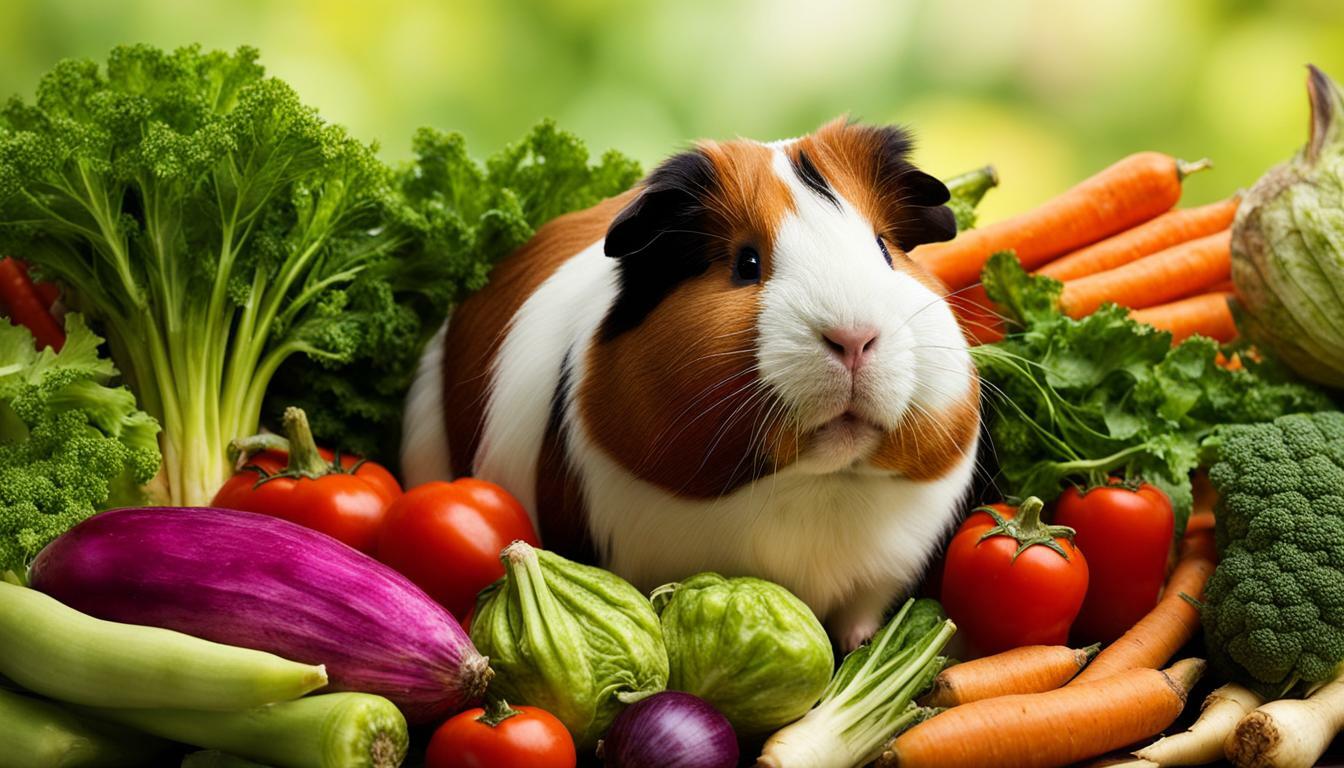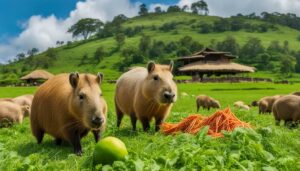If you’re wondering whether or not guinea pigs can have parsnips as part of their diet, you’ve come to the right place. Parsnips can provide nutritional benefits to guinea pigs, but it’s important to introduce them in moderation. This article will explore the topic of feeding parsnips to guinea pigs, discussing the health benefits, potential risks, and tips for incorporating them into their diet.
Key Takeaways:
- Parsnips can be included in a guinea pig’s diet, but in moderation.
- They are nutritious and offer vitamins and minerals that support guinea pig health.
- Overfeeding parsnips can lead to digestive and urinary problems.
- Some guinea pigs may not enjoy the taste of parsnips, so it’s important to try different vegetables and flavors.
- Wash and peel parsnips before serving them to your guinea pig.
- Provide a balanced diet that includes a variety of vegetables, hay, and limited fruits.
The Nutritional Benefits of Parsnips for Guinea Pigs
Parsnips are packed with essential nutrients that can contribute to a guinea pig’s overall health and nutrition. These root vegetables are rich in vitamins, minerals, and fiber, making them a valuable addition to a guinea pig’s diet.
One of the key nutrients found in parsnips is vitamin C, which is crucial for guinea pigs. These small animals are unable to produce their own vitamin C, so they rely on their diet to meet their needs. Parsnips contain a good amount of vitamin C, which helps support their immune system and aids in the production of collagen, promoting healthy skin and tissue.
In addition to vitamin C, parsnips also provide guinea pigs with important minerals such as potassium and manganese. Potassium is essential for maintaining a healthy heart and muscles, while manganese plays a role in bone development and overall growth. The fiber content in parsnips helps support good digestion and can prevent issues like constipation.
| Nutrient | Amount per 100g |
|---|---|
| Vitamin C | 17.0mg |
| Potassium | 375mg |
| Manganese | 0.6mg |
| Fiber | 3.6g |
While parsnips offer many nutritional benefits, it is important to feed them to guinea pigs in moderation. Their high oxalate and sugar content means that overfeeding parsnips can lead to health issues. It is recommended to provide parsnips as a occasional treat or include them as part of a varied vegetable diet. If your guinea pig shows any signs of digestive or urinary problems after consuming parsnips, it is best to consult with a veterinarian.
Moderation is Key: Feeding Parsnips to Guinea Pigs
While parsnips can be a healthy addition to a guinea pig’s diet, it’s crucial to feed them in moderation to avoid potential health issues. Parsnips contain oxalates and sugars that can cause digestive and urinary problems if consumed in large quantities. It’s best to offer parsnips as an occasional treat rather than a daily staple in their diet.
When introducing parsnips to your guinea pig’s diet, start with small pieces and observe their response. Some guinea pigs may not enjoy the taste of parsnips, so it’s important to respect their preferences and not force-feed them. Mixing parsnips with other vegetables can create different flavors and provide variety in their diet.
Before serving parsnips to your guinea pig, make sure to wash and peel them to remove any potential residue or dirt. This helps to ensure that your guinea pig is not exposed to any harmful substances that could negatively affect their health. Additionally, always remember to provide a balanced diet by incorporating a variety of vegetables, hay, and limited fruits to meet their nutritional needs.
| Parsnips for Guinea Pigs | Feeding Guidelines |
|---|---|
| Frequency | Occasional treat |
| Quantity | Small pieces |
| Preparation | Washed and peeled |
| Other Recommendations | Mix with other veggies for variety |
Conclusion
Parsnips can be a nutritious addition to your guinea pig’s diet when fed in moderation. They can provide essential vitamins and minerals, but it’s important to be mindful of the oxalate and sugar content. Remember to observe your guinea pig’s preferences and offer a balanced diet to ensure their overall health and well-being.
Introducing Parsnips to Your Guinea Pig’s Diet
When introducing parsnips to your guinea pig’s diet, it’s important to do so gradually and observe their reaction. Guinea pigs may have sensitive digestive systems, so introducing new foods slowly helps prevent any potential digestive upset.
Start by offering small pieces of parsnips alongside their regular vegetable servings. Monitor their response for any signs of discomfort or adverse reactions. If your guinea pig shows no signs of distress, you can continue to gradually increase the amount of parsnips in their diet over time.
Remember that parsnips should be fed in moderation due to their oxalate and sugar content. It’s recommended to limit the portion size of parsnips and offer them as a treat rather than a staple food. Mixing parsnips with other vegetables can also provide variety and different flavors for your guinea pig to enjoy.
| Parsnip Serving Suggestions | Frequency |
|---|---|
| Small pieces mixed with other veggies | 2-3 times a week |
| Parsnips as a standalone treat | Once a week |
It’s crucial to wash and peel parsnips before serving them to your guinea pig. This helps remove any potential residue or dirt that may be present on the skin. By taking these precautions, you ensure that your furry friend receives a clean and safe snack.
Remember that a balanced diet is essential for your guinea pig’s overall health and well-being. Alongside parsnips, ensure they have access to a variety of vegetables, fresh hay, and limited fruits. This ensures they receive the necessary nutrients and prevents any nutritional imbalances.
While parsnips can be a nutritious addition to your guinea pig’s diet, it’s important to remember that not all guinea pigs enjoy them. If your guinea pig doesn’t seem to like the taste of parsnips, you can try other vegetables that are safe for them to eat. Experimenting with different flavors and preferences can help you find the right combination that your guinea pig enjoys.
Parsnips as a Treat: Alternatives and Mixing Options
If your guinea pig doesn’t particularly enjoy the taste of parsnips, you can try mixing them with other veggies to create different flavors. Guinea pigs, like humans, have their own preferences when it comes to food. By combining parsnips with other vegetables, you can provide your furry friend with a variety of treats to keep their diet interesting and enjoyable.
Here are some alternative vegetables that you can mix with parsnips:
- Carrots: Carrots are a favorite among guinea pigs and can be mixed with parsnips to add a touch of sweetness.
- Cucumbers: Cucumbers are hydrating and refreshing, making them a great addition to parsnips.
- Bell peppers: Bell peppers come in different colors and provide a crunchy texture that guinea pigs love.
- Zucchini: Zucchini is a mild-tasting vegetable that can complement the earthy flavors of parsnips.
Remember to introduce new vegetables gradually, especially if your guinea pig is not used to them. This will allow their digestive system to adjust and minimize the risk of any discomfort. Additionally, always wash and peel vegetables before serving them to your guinea pig to remove any potential pesticides or dirt.
| Veggie | Taste | Benefits |
|---|---|---|
| Parsnips | Earthy, slightly sweet | High in fiber, vitamin C, and other essential nutrients |
| Carrots | Crunchy, sweet | Rich in beta-carotene, vitamin A, and antioxidants |
| Cucumbers | Refreshing, mild | Hydrating and low in calories |
| Bell peppers | Crunchy, slightly sweet | High in vitamin C and antioxidants |
| Zucchini | Mild, tender | Good source of vitamin C, potassium, and dietary fiber |
By offering a variety of vegetables, you can ensure that your guinea pig receives a well-rounded diet. Besides parsnips, other healthy treats for guinea pigs include leafy greens like spinach and kale, as well as fruits such as apples and berries. Remember to always provide these treats in moderation and alongside a consistent base of hay and fresh water to ensure your furry friend’s overall health and well-being.
Preparing Parsnips for Guinea Pigs
To ensure the safety of your guinea pig, it’s important to properly wash and peel parsnips before serving them. Guinea pigs have delicate digestive systems, so it’s crucial to remove any dirt, residue, or pesticides that may be present on the skin of the parsnips. Start by rinsing the parsnips thoroughly under running water to remove any surface impurities.
Once the parsnips are clean, use a vegetable peeler to remove the skin. This step is essential as the skin can be tough and difficult for guinea pigs to chew and digest. After peeling, use a sharp knife to cut the parsnips into small, bite-sized pieces that are suitable for your guinea pig’s mouth.
Table 1: Preparing Parsnips for Your Guinea Pig
| Step | Description |
|---|---|
| Step 1 | Rinse the parsnips thoroughly under running water. |
| Step 2 | Use a vegetable peeler to remove the skin. |
| Step 3 | Cut the parsnips into small, bite-sized pieces. |
It’s important to note that guinea pigs should only consume fresh parsnips. Avoid feeding them cooked or processed parsnips, as these can lose their nutritional value and may contain harmful additives. Also, remember to always wash your hands before handling parsnips or any other food that you will be serving to your guinea pig.
By taking the time to properly prepare parsnips for your guinea pig, you can ensure that they receive the maximum nutritional benefits while reducing the risk of digestive issues. Always monitor your guinea pig’s reaction to new foods, including parsnips, and consult with a veterinarian if you have any concerns about their diet or health.
Creating a Balanced Diet for Guinea Pigs
While parsnips can be included in a guinea pig’s diet, it’s crucial to provide a balanced mix of vegetables, hay, and limited fruits to meet their nutritional needs. Guinea pigs are herbivores and require a variety of nutrients to support their overall health and well-being.
When it comes to vegetables, guinea pigs should have a daily serving that includes leafy greens like romaine lettuce, spinach, and kale. These vegetables are rich in vitamins A and C, which are essential for guinea pigs’ immune system and overall health. Other vegetables that can be included in their diet are bell peppers, cucumbers, and carrots.
Hay, such as timothy hay, is an important component of a guinea pig’s diet. It helps to maintain dental health and provides necessary fiber for their digestive system. Make sure to provide fresh hay daily and ensure it is clean and free of dust or mold.
| Fruits | Suggested Frequency |
|---|---|
| Apples | Once a week |
| Strawberries | Once a week |
| Blueberries | Once a week |
When it comes to fruits, it’s important to remember that they should be given in limited amounts due to their high sugar content. Apples, strawberries, and blueberries are suitable options for guinea pigs, but they should only be fed once a week to prevent digestive issues.
Remember to introduce new foods slowly and monitor your guinea pig’s response. It’s also essential to provide fresh and clean water at all times. By offering a well-rounded and balanced diet, you can ensure the optimal health and happiness of your furry friend.
Potential Dislikes: Not All Guinea Pigs Enjoy Parsnips
It’s important to understand that not all guinea pigs may enjoy the taste of parsnips, so it’s worth trying different vegetables and flavors to find what they prefer. Some guinea pigs may have a more selective palate and may not take to parsnips right away. If your furry friend shows disinterest in parsnips, it doesn’t necessarily mean they don’t like all vegetables. Guinea pigs have individual preferences, just like humans, and it may take some experimentation to discover what they enjoy most.
One option is to mix parsnips with other safe vegetables that guinea pigs typically enjoy, such as carrots, bell peppers, or cucumbers. Combining different flavors can create variety and encourage them to try the parsnips. Additionally, you can try serving parsnips in different forms—cooked, raw, grated, or mashed—to see if they prefer a different texture or taste. Remember to introduce new foods gradually to prevent any digestive upset.
Observing your guinea pig’s behavior and response to various vegetables is crucial. Note their preferences and dislikes, and adjust their diet accordingly. It’s important to prioritize their well-being and enjoyment when it comes to their food choices. Providing a balanced diet that includes a variety of vegetables, hay, and limited fruits is key to ensuring their overall health.
Table 1: Safe Vegetables for Guinea Pigs
| Vegetables | Notes |
|---|---|
| Carrots | Rich in vitamin A, but feed in moderation due to sugar content. |
| Bell Peppers | Excellent source of vitamin C and low in sugar. |
| Cucumbers | High water content and a refreshing snack for guinea pigs. |
| Romaine Lettuce | Nutritious leafy green, but avoid iceberg lettuce. |
| Kale | Good source of various vitamins, but feed in moderation due to calcium content. |
Remember, each guinea pig is unique, and their preferences may change over time. By offering a variety of vegetables and experimenting with different flavors, you can ensure your furry friend enjoys a well-rounded and nutritious diet.
Conclusion
In conclusion, while parsnips can be a nutritious addition to a guinea pig’s diet, it is important to feed them in moderation and provide a balanced mix of vegetables, hay, and limited fruits for their overall well-being.
Guinea pigs can eat parsnips, but they should be given in small quantities due to their oxalate and sugar content. Overfeeding parsnips can lead to health issues such as urinary and digestive problems. It is also worth noting that not all guinea pigs may enjoy the taste of parsnips.
If your guinea pig doesn’t appreciate parsnips, you can try mixing them with other vegetables to create different flavors and provide variety in their diet. Before serving parsnips to your furry friend, it is essential to wash and peel them to remove any potential residue or dirt.
To ensure the health and well-being of your guinea pig, it is important to provide a balanced diet that includes a variety of vegetables, ample amounts of hay, and limited fruits. This balanced mix of nutrients will help support their overall health and keep them happy.
FAQ
Can guinea pigs eat parsnips?
Yes, guinea pigs can eat parsnips in moderation.
Are parsnips nutritious for guinea pigs?
Yes, parsnips are nutritious and offer health benefits for guinea pigs.
Why should parsnips be fed in small quantities?
Parsnips should be fed in small quantities due to their oxalate and sugar content.
What health issues can overfeeding parsnips cause in guinea pigs?
Overfeeding parsnips can lead to urinary and digestive problems in guinea pigs.
What if my guinea pig doesn’t like parsnips?
If your guinea pig doesn’t enjoy parsnips, you can try mixing them with other veggies to create different flavors.
How should parsnips be prepared before serving to guinea pigs?
It is recommended to wash and peel parsnips before serving them to guinea pigs.
Can parsnips be a regular part of a guinea pig’s diet?
Parsnips can be a part of a guinea pig’s diet, but should not be fed every day. A balanced diet with a variety of vegetables, hay, and limited fruits is important.




